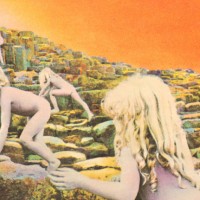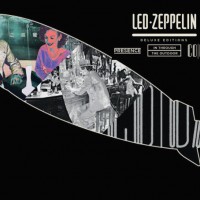Interesting statistic: each one of Led Zeppelin’s first five studio albums is between 41 and 45 minutes long. That’s about 20 minutes or so per side — typically the maximum amount of music one could fit on an album back in the days of vinyl LPs. Considering that many of their contemporaries’ releases totalled closer to 35 minutes or less, Zeppelin was doing a good job of delivering the big bang for the consumers’ big bucks.
Further to that, they usually recorded more tracks than could fit on the album, which then allowed them some flexibility in track selection and running order. Zeppelin’s fourth album (untitled or Zoso or whatever one wants to call it) and its follow up Houses of the Holy were both made pretty much this way, and many listeners think one or the other or both of these early 1970s albums represent the peak of Led Zeppelin’s studio work.
However, during the recording of their sixth studio effort Physical Graffiti, they ran into a problem: after they had recorded 8 songs, they realized the total time ran way past the typical 45 minute “limit” available on a standard two-sided vinyl LP. Now, many artists would have done some trimming and editing or simply cut one of the longer songs to rein the entire production back into the 40-odd minute comfort zone. Zeppelin, at the time the reigning rock gods of excess, instead did the most excessive thing they could: They added a few outtakes from their previous sessions and released Physical Graffiti as a sprawling double album.
That wasn’t such a bad idea: Though some critics thought Physical Graffiti was overhyped, overrated and overblown, the same could be said of many two-record sets released in the ’70s. And in spite of its piecemeal nature, Graffiti does hold together pretty well, showing all the different facets of the band’s musical influences and current interests.
However, in the modern age, it’s easy enough to rearrange the songs on computer playlists so that material originally recorded at about the same time appears on the same album as its session siblings. So, ignoring the time-format factor, here’s a thought on how those albums’ running orders might have gone — with each of them newly titled as a More Perfect Playlist …
Black Dog
Rock and Roll
Four Sticks
The Battle of Evermore
Stairway to Heaven
Night Flight*
Misty Mountain Hop
Goin’ to California
Boogie With Stu*
When the Levee Breaks
Zeppelins’ fourth album is, of course, a classic — and an almost untouchable classic at that. Still, the addition of “Night Flight” as the traditional Side Two opener is even more up tempo and catchier than “Misty Mountain Hop,” and “Boogie with Stu” provides a decent respite before the heaviness of “When the Levee Breaks.”
The Song Remains the Same
The Rover*
The Rain Song
Over the Hills and Far Away
The Crunge
No Quarter
Houses of the Holy*
Dancing Days
Black Country Woman*
D’yer Mak’er
Walter’s Walk**
The Ocean
This album improves greatly with the addition of three missing sheep from Graffiti (*) and one more from the band’s afterthought collection Coda (**). The songs on the original Houses of the Holy have always seemed unconnected to each other: part progressive rock, part send ups of old rock ‘n’ roll and R&B stylings, and part the standard acoustic/electric patented Zeppelin take on heavy rock. This whole sense of disconnect was further compounded by Jimmy Page’s weird guitar treatments and the more than usual prominent keyboard work of John Paul Jones. But the missing title track “House of the Holy,” “The Rover,” “Black Country Woman” and “Walter’s Walk” all rock pretty hard and solidify the album so it doesn’t sound so jarring and experimental.
Custard Pie
Trampled Underfoot
Kashmir
Ten Years Gone
In the Light
The Wanton Song
Sick Again
In My Time of Dying
The original 8 songs recorded for the Physical Graffiti album are actually pretty strong in and of themselves. The album opens with two relatively short rockers, “Custard Pie” and “Trampled Underfoot,” and then goes directly to the centerpiece, “Kashmir.” Then, a few more tunes, and finally onto the album closer, “In My Time of Dying,” which proves once and for all that Led Zeppelin was never really just a blues band. They eventually developed a unique style of their own that many have attempted to duplicate over the years, but have rarely come close to it.
- How David Bowie’s ‘The Next Day’ Stripped Away All of the Artifice - March 15, 2023
- Why Deep Purple’s ‘Who Do We Think We Are?’ Deserves Another Listen - January 11, 2023
- In Defense of the Often-Overlooked Mott the Hoople - November 10, 2022





Very nice playlisting, must cue up these tracks as suggested to see how they flow together, (have often thought about a similar re-jigging of Presence, ITTOD & Coda)